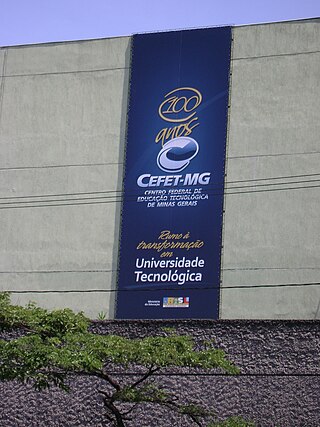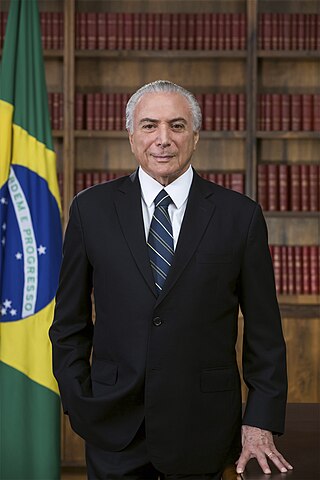
Minas Gerais is one of the 27 federative units of Brazil, being the fourth largest state by area and the second largest in number of inhabitants with a population of 20,539,989 according to the 2022 census. Located in the Southeast Region of the country, it is limited to south and southwest with São Paulo; Mato Grosso do Sul to the west; Goiás and the Federal District to the northwest; Bahia to the north and northeast; Espírito Santo to the east; and Rio de Janeiro to the southeast. The state's capital and largest city, Belo Horizonte, is a major urban and finance center in Brazil, being the sixth most populous municipality in the country while its metropolitan area ranks as the third largest in Brazil with just over 5.8 million inhabitants, after those of São Paulo and Rio de Janeiro. Minas Gerais' territory is subdivided into 853 municipalities, the largest number among Brazilian states.

Education in Brazil has had many changes. It first began with Jesuit missions, that controlled education for a long time. Then, two hundred years after their arrival, their powers were limited by the Marquis of Pombal. Shortly after the Jesuits' power was limited, the Brazilian government took over education and it is now run by the government through the Ministry of Education.

Podemos, previously known as the National Labour Party is a centre-right Brazilian political party. Historically labourist and Janist, since 2016 the party shifted its focus to support anti-corruption policies and direct democracy.

The Amazonas State University is a Brazilian public university operated by the state of Amazonas, located in Manaus, Amazonas, Brazil. It was established in 2001 by a state law that turned the University of Technology of Amazonas into the UEA. In 2011, UEA was ranked the best university of the state in an evaluation made by the Ministry of Education.

Exame Nacional do Ensino Médio, shortened as Enem, is a non-mandatory, standardized Brazilian national exam, which evaluates high school students in Brazil. The ENEM is the most important exam of this kind in Brazil, with more than 8.6 million registered candidates in 2016. It is the second largest in the world after China's National Higher Education Entrance Examination.

The Federal Center for Technological Education of Minas Gerais is an education center located in the Brazilian state of Minas Gerais.
The Federal University of Sergipe is a Brazilian public institution based in Sergipe, with campuses in São Cristóvão, Aracaju, Itabaiana, Laranjeiras, and Lagarto. Founded in 1967 by the junction of the state's existing colleges, it became its second university and its first public one. It became the state's most reputable and disputed higher education institution, ranking among the country's 40 best universities and Latin America's top 200 list.

Fernando Haddad is a Brazilian scholar, lawyer and politician who has served as the Brazilian Minister of Finance since 1 January 2023. He was previously the mayor of São Paulo from 2013 to 2017 and the Brazilian minister of education from 2005 to 2012.

The New Party is a classical liberal, libertarian party in Brazil founded on 12 February 2011.

Fabiano Augusto Martins Silveira is a Brazilian lawyer and politician. He is a legislative advisor to the Federal Senate of Brazil and was briefly the Minister of Transparency, Supervision and Control of Brazil.

The 2017 labor reform in Brazil was a significant change in the country's Consolidation of Labor Laws. According to the government, the goal of the reform was to combat unemployment and the still ongoing 2014 Brazilian economic crisis.

Romeu Zema Neto is a Brazilian businessman, administrator, and politician affiliated with the NOVO party. The current Governor of the state of Minas Gerais, Zema served as the head of the Zema Group, an industrial conglomerate, from 1990 to 2016. First elected in 2018, he won 42.73% of the valid votes, qualifying for a second round against Antônio Anastasia. Winning with 72.80% of the votes, he was inaugurated in 2019.

The Student mobilisation in Brazil in 2016 corresponded to a series of demonstrations and occupations in Brazilian secondary schools and universities that intensified during the second half of 2016. The mobilisations were carried out by high school and university students in several states in Brazil.
Auxílio Brasil was the social welfare program of the Government of Brazil, created during the presidency of Jair Bolsonaro. Announced in October 2021, the provisional measure was sanctioned by Bolsonaro after passing through both legislative houses on 30 December 2021, replacing Bolsa Família. However, after Lula's reelection as president of Brazil in 2022, he declared that he would rename the program to Bolsa Família, putting an end to Auxílio Brasil.

The 57th Legislature of National Congress is the current meeting of the legislative branch of the Federal Government of Brazil, composed by the Federal Senate and the Chamber of Deputies. It convened in Brasília on 1 February 2023, a month after the inauguration of the winner of the 2022 presidential election.

The presidency of Michel Temer began on May 12, 2016, when the vice-president of the Republic, Michel Temer, temporarily assumed the position of president of the Brazilian Republic, after the temporary removal of President Dilma Rousseff, as a result of the acceptance of the impeachment process by the Federal Senate. Once the process was concluded, on August 31 of the same year, Temer took over the position permanently, which he held until January 1, 2019, when the administration of Bolsonaro began.
The Fundo de Financiamento ao Estudante do Ensino Superior, also known as FIES, is a Brazilian Ministry of Education program created in 1999 with the aim of financing higher education degrees for students enrolled in private institutions. It allows students to start paying their tuition fees only after graduation.

The presidency of Fernando Henrique Cardoso began on January 1, 1995, with the inauguration of Fernando Henrique, also known as FHC, and ended on January 1, 2003, when Luiz Inácio Lula da Silva took over the presidency.

The 2016–2017 Brazilian protests were popular demonstrations that took place in different regions of Brazil after Dilma Rousseff's impeachment. The marches were marked by the slogan "Fora Temer".
The Sistema de Seleção Unificada is a digital platform launched in January 2010 and developed by the Brazilian Ministry of Education (MEC). It is used by students who attended the National High School Exam to apply to higher education institutions that use ENEM scores as a method of admission. From 2024, the system will be limited to one edition per year, which will be held in January.


















